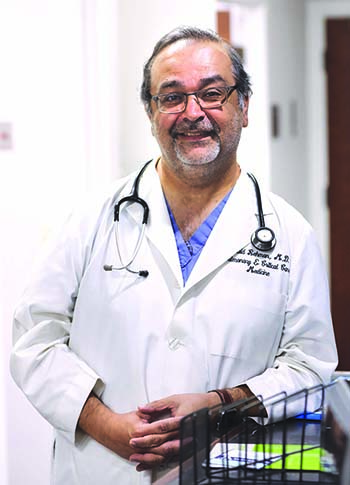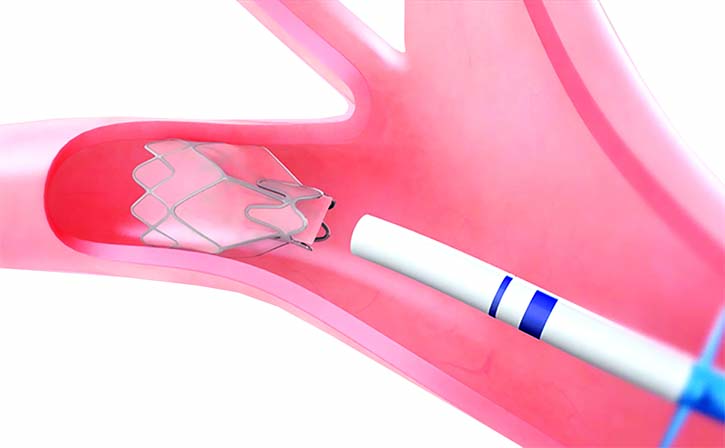Breathing Easier With The Pressure Off
A specialized valve can help patients with advanced emphysema
You did it! You quit smoking.
The cravings were tough, but as time went on, they got weaker. Meanwhile, you got stronger. Your muscles and bones got more oxygen, your immune system improved, your blood pressure went down and even your teeth got whiter.
But you still struggle to breathe. That most likely means you have Chronic Obstructive Pulmonary Disease, or COPD.
COPD is a group of diseases that are characterized by persistent respiratory symptoms and airflow limitations that make it hard to breathe. It includes chronic bronchitis and emphysema. Smoking is the number one cause of COPD.

“This is the third most common cause of death in Georgia after heart disease and cancer,” says pulmonologist Obaid Rehman, MD, of Southeast Lung Associates. “It’s a very, very common problem.”
A New Option For Severe Emphysema
COPD is so common that there are a large number of patients who have a certain subtype called centrilobular emphysema. This means that damage to your respiratory passageways begins in the center of the lungs and spreads outward. It’s a progressive disease, and even those who have successfully quit smoking will still deal with shortness of breath, even when doing simple activities like yard work, taking a walk or riding a bike.
Dr. Rehman says that when you reach the advanced stages of this kind of emphysema, there aren’t many treatment options left. But there is one new option, and Dr. Rehman is currently the only physician in the region to offer it in the bronchoscopy suite at St. Joseph’s/Candler. Without needing to use surgical incisions, Dr. Rehman can place one or more small devices, called Zephyr valves, into your damaged airways.
“With emphysema, weakened air sacs rupture to create large air spaces, which causes damaged parts of the lung to get larger and put pressure on the diaphragm, making it harder to breathe,” Dr. Rehman explains. “It’s like if your car is driving unbalanced and you realize you have too much air in one tire. You have to let some of the air out, and that’s what this tiny valve does.”
How It Works
Dr. Rehman first works with your primary care physician or other medical provider to determine your candidacy for the Zephyr valve. Some of the requirements include:
- A diagnosis of severe, late-stage emphysema
- Being healthy enough to undergo a bronchoscopic procedure
- No active lung infections
- No allergies to Nitinol, nickel, titanium or silicone
- Having successfully quit smoking
No incisions are necessary for the procedure, but patients can expect a three day hospital stay for observation because there is a chance for a complication when a lung is deflated. Patients are given anesthesia for the procedure, which takes about 30 minutes to an hour.
Dr. Rehman guides a bronchoscope, which is a small tube with a camera, through the nose or mouth and into the lungs. Then each Zephyr valve is channeled through the bronchoscope and placed in the damaged airways.

Typically each section of a lung, called a lobe, can receive three to five valves per procedure. If more than one lobe needs valves, a patient may have to have the procedure again about six weeks after the first.
“Once in place, I open up the valve, almost like a little umbrella,” Dr. Rehman says. “These are one-way valves. It lets the air out but doesn’t let it back into a certain lobe. So the damaged parts of your lungs are not expanding and the pressure is taken off the diaphragm.”
Walking On Air
Dr. Rehman reminds his patients that the benefits from the procedure aren’t usually felt for about four to six weeks. But once they arrive, they are felt clearly and deeply.
“Before the valve, patients might say they feel like they are running all the time,” Dr. Rehman says. “But now they’re not struggling to breathe. And that is reflected in the pulmonary function testing that we do here. The patient’s lung capacity gets better. Patients have also taken walking tests, which measure endurance capacity, and those also improve after the valves are implanted.”
While he says the Zephyr valve is not a cure, Dr. Rehman sees it as a great way for people with severe emphysema to experience the relief of breathing better again.
“I have a patient that just likes to go to the mall, maybe even have fun at the casino,” he says. “She wants to be able to live her life independently, to walk and to drive without the fear of gasping for breath. Now, after the Zephyr valve procedure, she can continue to do what makes her happy and keep living her life.”
To learn more about COPD and what treatment options are available in its earlier stages, read our Living Smart blog.
For more information on St. Joseph’s/Candler’s Tobacco Cessation Program, click here.
To learn more specifically about emphysema, a form of COPD, take our quiz.